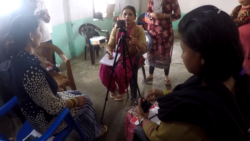Our Approach
Within CE4AMR, community engagement incorporates participatory and creative methods to deliver realistic and sustainable solutions that are locally relevant to each community. The network includes common global health sector methods such as the Community Dialogue Approach, Women’s discussion groups, Community Health Clubs and more. Our aim is always to embed such methods within existing systems and give the community space to explore AMR (or other One Health issues). This means knowledge exchange is a two-way dialogue between researchers and the community, and interventions become more than simple awareness raising tactics. However, CE4AMR realises that the specificity of such approaches can make them challenging to evaluate and scale. The network is particularly keen to draw out synergies between successful community engagement projects and develop best practice resources to ensure more communities, practitioners and researchers can engage with these approaches.
Our aim is always to embed such methods within existing systems and give the community space to explore AMR (or other One Health issues). This means knowledge exchange is a two-way dialogue between researchers and the community, and interventions become more than simple awareness raising tactics. However, CE4AMR realises that the specificity of such approaches can make them challenging to evaluate and scale. The network is particularly keen to draw out synergies between successful community engagement projects and develop best practice resources to ensure more communities, practitioners and researchers can engage with these approaches.
We champion participatory methods, especially those that impact on health outcomes, but we are also interested in the wider benefits of such approaches. For example, attending a local AMR discussion group can increase confidence and develop the communication skillset of participants. This builds community ownership in terms of tackling the problem of AMR, but also contributes to individual personal and professional skillsets.  We also recognise the value of creative methods culminating in the development of outputs including films, dramas and other artistic forms to tackle AMR. This is because the process of creative development is recognised to contextualise and clarify the learning of participants. Community-produced, and creative outputs are attractive and relatable, meaning they have great scope to communicate the desired messages to wider audiences. Being owned by the community develops a level of trust and ‘soft power’ which can allow these outputs to act as advocacy tools and influence higher-level stakeholders around the community, including local governments and policy makers.
We also recognise the value of creative methods culminating in the development of outputs including films, dramas and other artistic forms to tackle AMR. This is because the process of creative development is recognised to contextualise and clarify the learning of participants. Community-produced, and creative outputs are attractive and relatable, meaning they have great scope to communicate the desired messages to wider audiences. Being owned by the community develops a level of trust and ‘soft power’ which can allow these outputs to act as advocacy tools and influence higher-level stakeholders around the community, including local governments and policy makers.
We believe that community, participatory and creative methods can, in combination, be valuable in tackling AMR, because they truly engage a community in a problem that matters to them and allows the community to develop solutions that will work in their local context. This bottom-up approach means that AMR behaviour change is possible even before slower top-down changes, for example to health care or pharmaceutical systems, have been fully implemented.
